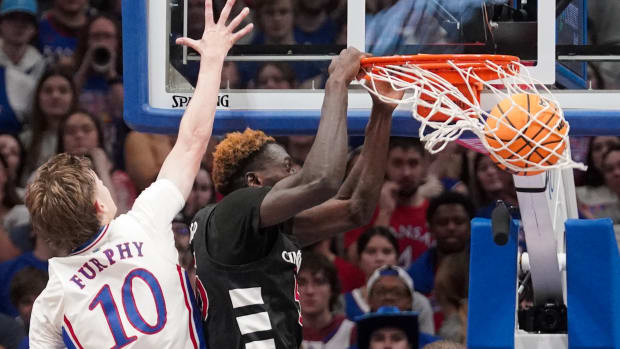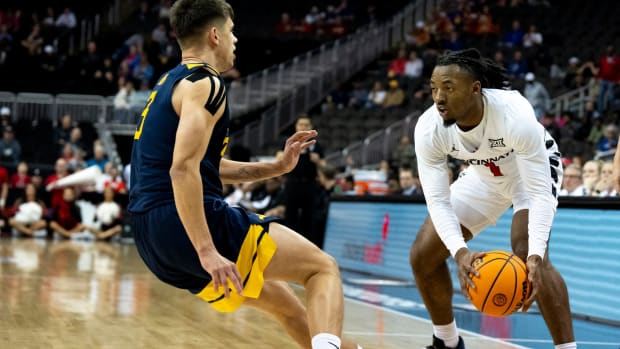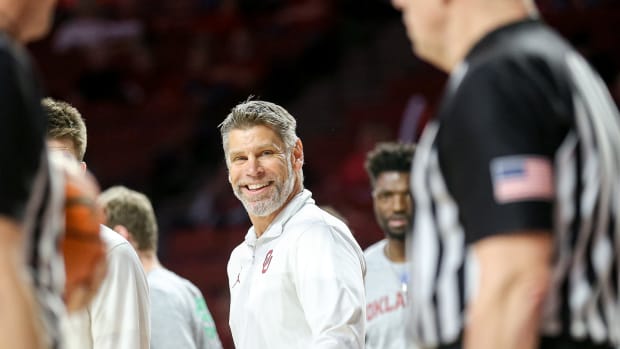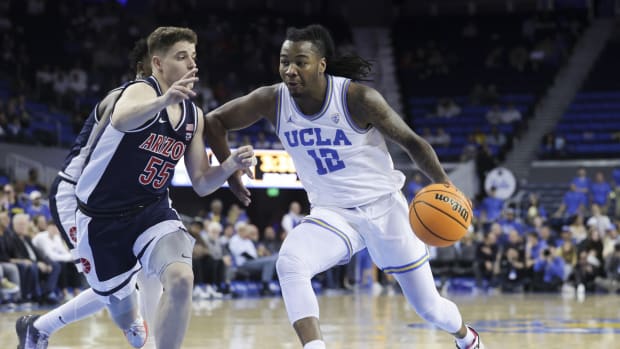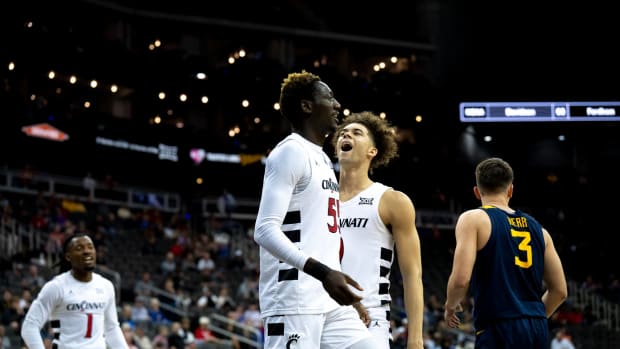How Kelsey Plum and Sydney Wiese transformed their programs; Sweet 16 reset
SEATTLE — A few weeks ago between games at the Pac-12 women’s basketball tournament at Key Arena, I popped into the bathroom and witnessed a scene that perfectly encapsulates women’s basketball on the West Ccoast right now.
At the sink, a young mother washed her hands while her toddler daughter, who looked to be 3 or 4, dribbled a small basketball underneath the paper towel dispenser. “Look mama!” she said. “I’m dribbling! I’m dribbling like Kelsey, I’m dribbling!”
She was referring, of course, to Washington guard Kelsey Plum, the darling of women’s college basketball who also happens to be the sport’s all-time leading scorer. A 5’ 8” shooting guard blessed with tremendous work ethic instead natural athleticism, Plum played her last game in Seattle Monday night when she led Washington to a 108–82 win over Oklahoma in the second round. With the victory, Washington advances to its second consecutive Sweet 16, and a Saturday date with No. 2 seeded Mississippi State. Plum and her crew got quite the send off Monday night in Alaska Airlines Arena, as 7,579 boisterous fans—many of them little girls shouting “Kelsey Plum! Kelsey Plum!”—packed into the Dawgs’ house to cheer them on. The likely Wade Trophy winner, Plum has inspired a generation of girls in the Pacific Northwest to pick up basketballs and get in the gym. But she’s not the only one.
Just 215 miles south on Interstate-5, Oregon State guard Sydney Wiese played her final game in Gill Coliseum Sunday night, as the Beavers held off Creighton 64–52 to also advance to their second straight (and second ever) Sweet 16. Wiese has inspired a similar following at OSU, where little girls show up in headbands (Wiese’s trademark) and mimic shooting threes (Wiese is the Pac-12’s all-time leader in makes). Sunday morning, the local beat writer from the Corvallis Gazette-Times newspaper wrote a column thanking Wiese for all she’s done for his young daughter.
What Plum and Wiese have done on the floor is beyond impressive; both played huge roles last season in leading their programs to the Final Four. But to me what’s more telling are the growing fan bases they’ve helped build. Oregon State leads the league in attendance, averaging 4,353, while Washington typically draws 3,640. Washington’s attendance increased by 1,760 fans per game compared to last season, the third largest increase in the NCAA behind Central Florida and Hawaii. The other factor to consider in this conversation: These players walked into big rebuilding situations four years ago. Before Plum and Wiese’s classes arrived at Washington and Oregon State, respectively, neither school had finished in the top three in conference since the 2002-03 season. Simply put, Seattle and Corvallis were not destination locations for big-time women’s basketball prospects.
Far from home, Texas's Lashann Higgs found new family, future through basketball
Oregon State senior Gabby Hanson, the Pac-12’s defensive player of the year and a member of the first-ever class in OSU women’s basketball history to earn four consecutive NCAA Tournament bids, saw a vision when she visited Corvallis for the first time.
“We saw what this place could be,” Hanson said Sunday night after the senior class had wrapped up its 60th win in Gill Coliseum. (OSU’s 2017 class finished 60-6 over four years, while Plum & Co. went 52-12).
“I think (Sydney and I) both can attest to when we came on our visits … everyone wanted this program to do well. They just didn’t really have the right ‘stuff’ yet.”
Ditto at Washington. When UW coach Mike Neighbors subbed out his three seniors—Plum, plus forwards Chantel Osahor and Katie Collier—Monday night, they huddled on the floor and he told them to remember what that roar sounded like, and to remember their freshman year, when the gym was mostly empty.
“You have to give them (the fans) a reason to come out,” Neighbors said afterward. “It takes time. You have to get a winning product on the floor. You have to work at it. We have a great marketing team across camps. We became a priority and people (in the community) really responded.”
The wins and attendance numbers—both OSU and UW recorded sellouts this year, each against Stanford at home—signal a growing shift in a powerhouse conference, and in the women’s basketball landscape in general. So do the conference championships, where Oregon State has dominated in recent years, winning three in a row.
Stanford, which has won 22 Pac-12 regular season titles under legendary coach Tara VanDerveer, isn’t going anywhere, but the Cardinal were third in attendance this season, averaging 3,160. Stanford won the Pac-12 tournament and drew a No. 2 seed in the NCAA tournament, where the Cardinal faces Texas Friday in the Sweet 16. Oregon State, which won the Pac-12 regular season championship, earned the conference’s only two seed; Washington was also a three.
Forever, the Pac-12 (then the Pac-10) was considered Stanford and everyone else. That’s hardly the case now. A whopping five Pac-12 teams are playing in the Sweet 16, a fitting number for the No. 1 RPI conference in the country. The biggest surprise is 10th-seeded Oregon, which executed beautifully in the final 33 seconds against No. 7 Temple to pull out a 71–70 win in the first round before handling Duke, 74–65, on the Blue Devils’ home court. A warning to women’s basketball: The Ducks start three freshmen, and presumably are just getting started. And this is all without mentioning UCLA, which dominated Texas A&M in the second round, and has one of the most exciting players in the nation in point guard Jordan Canada.
For all the chatter about UConn’s dominance, there absolutely is growing parity in the women’s game. (If you need proof from the east coast, get familiar with No. 12 seed Quinnipiac, which plays in the Sweet 16 against No. 1 seed South Carolina in the Stockton Regional Saturday.) And so long as more little girls want to be like Kelsey and Sydney—along with the ones who already want to be like Katie Lou (Samuelson) and Gabby (Williams)—that parity will continue to grow. These are the beginning stages of a shift in women’s basketball, and they’re incredibly fun to watch.
Sweet 16 Burning Questions
1. Is the second time a charm for Maryland?
The Terps, the most talented No. 3 seed in the tourney, played a role in keeping the undefeated Huskies, well, undefeated. Maryland and UConn played way back in December, with UConn escaping with an 87–81 win in College Park. Provided they win their Sweet 16 matchups (Maryland over Oregon, and UConn over UCLA), they’ll meet again with a trip to Dallas on the line. UConn isn’t deep, and Maryland has the bigs (most notably Brionna Jones, a solid 6 ’3” center who averages 20 points and 10.7 rebounds) to hurt the Huskies down low. But the flip side of that is that UConn is lethal from every position. Five Huskies scored in double figures in the blowout win over 16-seed Albany, and Kia Nurse went a 9-of-12 from three in the 30-point victory over Syracuse. You have to control pace to beat UConn, but you also have to score (Maryland leads the country in scoring, at 90.1 points per game). Doing both for 40 minutes is exhausting.
Bridgeport pick: UConn
2. Does Baylor’s dominance continue in Oklahoma City?
It’s been a rough couple weeks for Baylor from a PR standpoint but clearly off the court controversies aren’t hurting the Lady Bears on the court. Baylor rolled through its first two games, blitzing poor Texas Southern 119–30 (it was the most lopsided victory in NCAA women’s tournament history) before thumping Cal 86–46. Oklahoma City is probably the most interesting region with No. 1 seed Baylor, No. 2 seed Mississippi State, No. 3 seed Washington and No. 4 seed Louisville. There’s an argument to be made for any of those teams winning the regional title. But Baylor has lost in the Elite 8 three straight years—last year to upstart Oregon State—and with the Final Four being played just 90 miles from Waco, the Lady Bears seem determined to not only get to Dallas, but to do it with big margins of victory.
Oklahoma City pick: Baylor
3. Can the mentee upset the mentor?
Women’s basketball junkies knew what was coming the second the bracket was released: Ohio State head coach Kevin McGuff in a potential Sweet 16 showdown with his former boss, Notre Dame coach Muffet McGraw. Well, we got what we wished for. McGuff spent six seasons on Notre Dame’s bench, helping the Irish to the 2001 title. (Current Notre Dame associate head coach Niele Ivey was the point guard on that national championship team, worked for McGuff at Xavier from 2005-07 and remains close with McGuff and his wife, Letitia.) McGuff’s Ohio State squad, led by junior speedster Kelsey Mitchell (22.7 ppg), loves to push pace and averages 86 points per game, fourth-best in the country. Notre Dame, the No. 1 seed in the Lexington region and a title contender, is dealing with the heartbreaking loss of post player Brianna Turner. Turner (15.3 points, 7.1 rebounds) tore her left ACL in the Irish’s second-round win over Purdue. It’s a devastating loss for the Irish.
Lexington pick: Stanford
4. How healthy is South Carolina really?
If you thought Notre Dame had injury issues, just wait. South Carolina is for sure down one of its best players, with post Alaina Coates sidelined all postseason with a severe ankle injury, but the Gamecocks were dealt another blow in their second-round nailbiter over Arizona State, when junior guard Allisha Gray (12.8 ppg) jump stopped hard and crashed to the ground in USC’s last game. Gray, who was in obvious pain, was carried off the floor, though coach Dawn Staley has said Gray will be ready to go for South Carolina’s Sweet 16 matchup with Quinnipiac. Still, one has to wonder if the Gamecocks, who had to mount a furious rally against 8th-seeded Arizona State, are primed for an upset without a totally healthy roster.
Stockton pick: Florida State

